So, where does coffee come from you ask? Like most consumer goods, the convenience of pre-packaged processed coffee beans makes you grow more distanced from and ignorant of their origin, coffee plants, than ever before.
Well, that’s the whole point of mass production and mass distribution.
But, once in a while, while waiting for the water to boil or your coffee to be ready, you randomly decide to read the labels and contents on your coffee bean bag that you have often ignored since you put it in the cart.
And your mind starts wandering.
Million cups of coffee per day yet we’re so clueless about it. Before going through the roasting process in the roasting machine, where does coffee come from?
Where are the coffee trees grown? How many types are there? How are they processed?
And today is the day your questions are answered, which can be found in this article.
Be sure to check out the Where Does Coffee Come From illustration at the very bottom of the article.
What Does A Coffee Plant Look Like
If you aren’t already aware, coffee comes from the fruit of the coffee plants.
They are often small and short due to regular pruning, only about the size of a leafy house plant.
That’s not their height limit, however. A grown coffee tree can be observed to reach as high as 30ft (9m) tall!
They characteristically have dark green shiny waxy leaves growing in pairs in opposite directions, but you can spot naturally yellow and purple waxy leaves as well.
Along the branches of the coffee plant, bunches of rich red ripe coffee cherries grow and pop up around the leafy greens like pops of colors.
The seeds inside these coffee cherries are the original forms of the processed and roasted coffee beans you use to brew a coffee cup.
Each of the coffee cherries contains two seeds.

How Long Does It Take For A Coffee Plant To Grow
But a coffee tree once planted cannot produce commercially harvested coffee beans right away.
Even after the first flowering, it can still take them up to around four years to fully mature for full fruit production.
The cycle of production of a coffee plant can be observed in the following sequence:
- The blooming of beautiful and fragrant white coffee flowers, lasting a few days before their eventual withering and fall.
- The formation and growth of green coffee berries from the developed nodes in a period of more than half a year depending on the rainy season’s length.
- The ripening of the berries causes them to turn into either yellow or red coffee cherries depending on their coffee kind, meaning they are ready to be harvested.
But the coffee plant grows in a continuous cycle, so you may spot all of the aforementioned at the same time on the same coffee tree!
And even though it’s not entirely outrageous to say we can grow old with a coffee plant, 7 to 20 years of age is generally their most productive range.
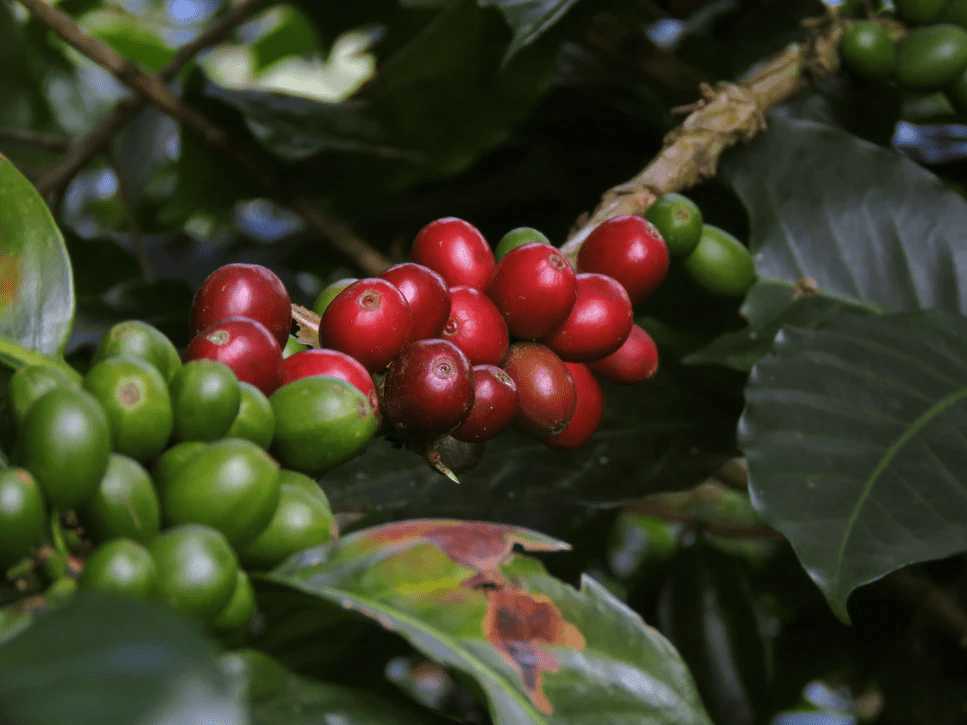
What Type Of Coffee Plants Are There
Now, are there different types of coffee plants? Yes, definitely. They are under the Coffea genus.
According to the National Coffee Association of U.S.A. [NCA], there can be as many as 100 species of Coffee around the world.
However, among this impressive diversity, Arabica and Robusta coffee dominate the commercial coffee production industry, which you’re probably already familiar with and often factor into your choice of coffee bean consumption.
Some coffee enthusiasts may also know of other types such as Liberica and Excelsa coffee.
And most of the coffee consumed around the world is grown in the Bean Belt, comprising Central America and South America, Africa, and the Middle East and Southeast Asia.
Arabica – Coffea Arabica
So, what is the most common coffee plant? Arabica, especially popular in North America.
In fact, over 70% of the world’s coffee market share belongs to these beans, so it’s not an understatement to say it is the most commercialized type of coffee as well.
Currently, Brazil in South America has been a top producer of Arabica for many decades.
The story is, Arabica coffee comes from the first coffee forests discovered in the Ethiopia plateau by a goat herder named Kaldi back in 1,000 BC.
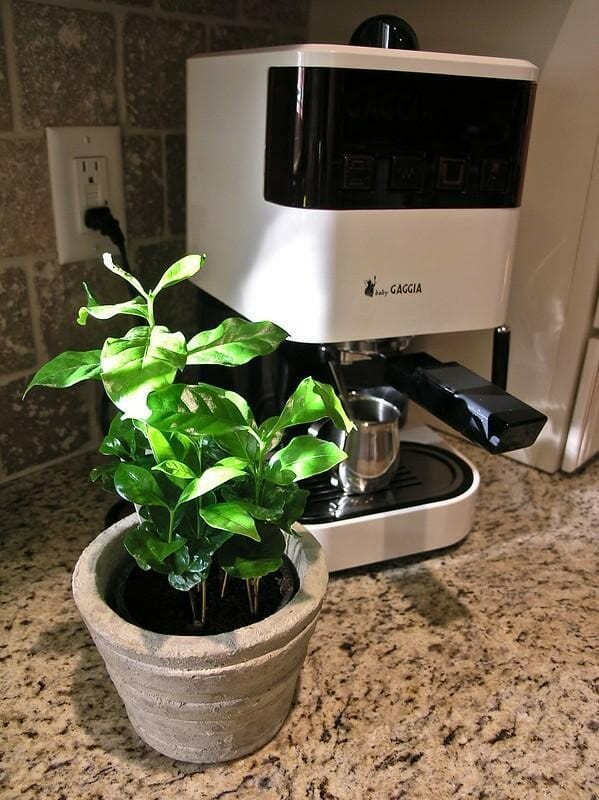
However, the first coffee trees ever cultivated were not in Ethiopia, but in the Arabian Peninsula around the 7th century, which led to the rise of the term (you guessed it!) “Arabica” coffee bean.
Not only did Arabica win the crown to be the biggest coffee phenomenon in today’s world, but it’s also likely the oldest coffee species known to mankind.
To be able to supply caffeine boosters for around three-quarters of the globe, coffee cultivation had to branch outside its origins.
Though they can be planted anywhere, the better Arabica beans are grown in high altitudes, around 2,000-6,000ft (610-1,830m) above sea level, which may vary depending on the location’s proximity to the equator.
That suggests they can withstand the cold temperature. But, nobody likes frostbites, and neither does the Arabica plant.
Together with the mild temperature, steady rainfall, and plentiful shades are beneficial to their growth as well.
Despite their commercial popularity, coffee plantations for these plants are actually more costly than their cousin Robusta.
What’s more, growing them in large quantities to achieve a large volume of harvests can raise the stakes as well.
Though they’re generally easy to care for in the right environment, their disease-prone characteristic may set off a domino effect causing an unwanted outbreak among the entire crop.
So what makes Arabica coffee beans capable of capturing the hearts of so many coffee drinkers?
Its mild, sweet yet light taste with less acidity and distinctly fruity and chocolaty notes are the X-factor.
If you have stomach concerns and are considering buying low-acid coffee, opting for Arabica beans is a good start. I have an article to help you find just the right coffee brand!
Therefore, the superior coffee flavor profile and the higher cost of production drive its price past Robusta.
Nevertheless, nobody’s perfect. It is amazing when served hot using brewing methods such as pour-over or drip. But it loses the advantage when it comes to cold serves or milk or creamer blends.
Robusta – Coffea Canephora
Coffea Canephora, or Coffea Robusta, accounts for most of the rest of the world’s coffee consumption pie, which is around 30%, especially popular in Europe and the Middle East.
According to the NCA, today, most of the time, Robusta coffee comes from Central and Western Africa, Brazil, and parts of Southeast Asia such as Indonesia and Vietnam, all of the big coffee production names.
Robusta coffee plant is even easier to grow than its aforementioned cousin.
Hale and hearty, less prone to diseases, and more resistant to heat, these coffee plants can be cultivated in lower altitudes and warmer climates at a cheaper cost.
What both coffee tree species have in common is, they wither in frost.
While the cousin radiates the “sugar and spice and everything nice” energy, the taste of Robusta is more bitter and bolder with earthy undertones. It’s also notably higher in acidity and caffeine content.
The cheaper production cost and the less delicate and complex coffee taste palette make its price cheaper in comparison to its aforementioned cousin.

This doesn’t mean that Robusta can’t be enjoyed as much as its cousin, though.
While the latter’s flavor is diminished when served cold or blended with milk or creamer, the former is more bitter, and grainier taste pairs well with sugary styles, perfect for coffee lovers with a sweet tooth.
In fact, it makes a “mean” cup of Vietnamese Coffee or Vietnamese Iced Coffee, one of the top producers and exporters of Robusta coffee beans.
If you ever have the time to drop by Hanoi, the capital, try out at least one specialty coffee shop for an authentic local coffee experience.
What’s more, most of your favorite espresso coffee actually contains a blend of both Arabica and Robusta beans.
Premium Robusta beans are also being produced around the world to overcome their second-rate coffee reputation.
Under strict growing conditions, this coffee, too, can become less acidic and sweeter while retaining its signature toastiness.
Robusta plants’ reliability is also one of the factors causing it to rise in popularity among coffee producer farms, so we can expect to see more of it in the future.
Harvesting Coffee Beans
According to the NCA, a coffee plant can typically produce around 10lbs (4.5kg) of coffee cherries each year.
Generally, there is only one annual major harvest. But in some countries such as Colombia, flowerings can be sighted twice, so there can be two harvests for the main and secondary crops.
As aforementioned, the coffee plants grow in a continuous cycle, so you can observe all stages of growth and their products on one tree.
But only the ripe coffee cherry is needed. So, how does a coffee producer implement the harvesting process productively? There are two ways to approach this.
Strip Pick
Either by hand or machine, all berries are stripped off at one time, regardless of whether they’re ripe or not.
Selectively Pick
This method is a lot more labor-intensive and time-consuming, hence, usually reserved for the more deluxe Arabica coffee beans.
Only the ripe deep red cherries are picked individually by hand.
The pickers also go back and forth to check every week during the harvest period.
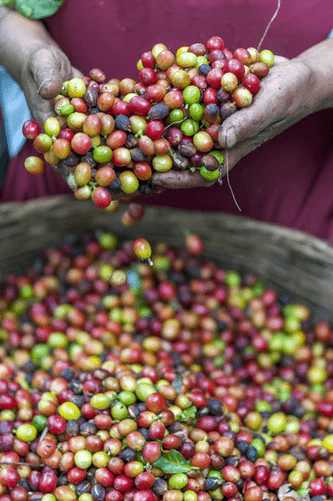
Drying Coffee Beans
After the beans are harvested, they are transported to the process plant immediately to be processed and dried in two methods:
Dry Method
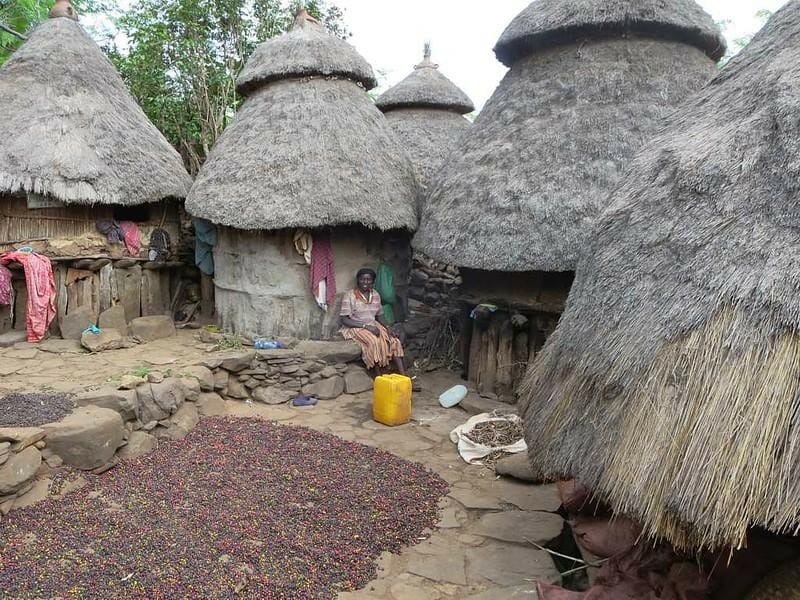
Simple, low-cost, yet get the job done. This is the traditional method of coffee cherry processing.
For a few weeks, the freshly picked ones are sundried on a large surface, raked and turned regularly, and covered at night or during bad weather, until they reach around 11-13% of moisture level.
Wet Method
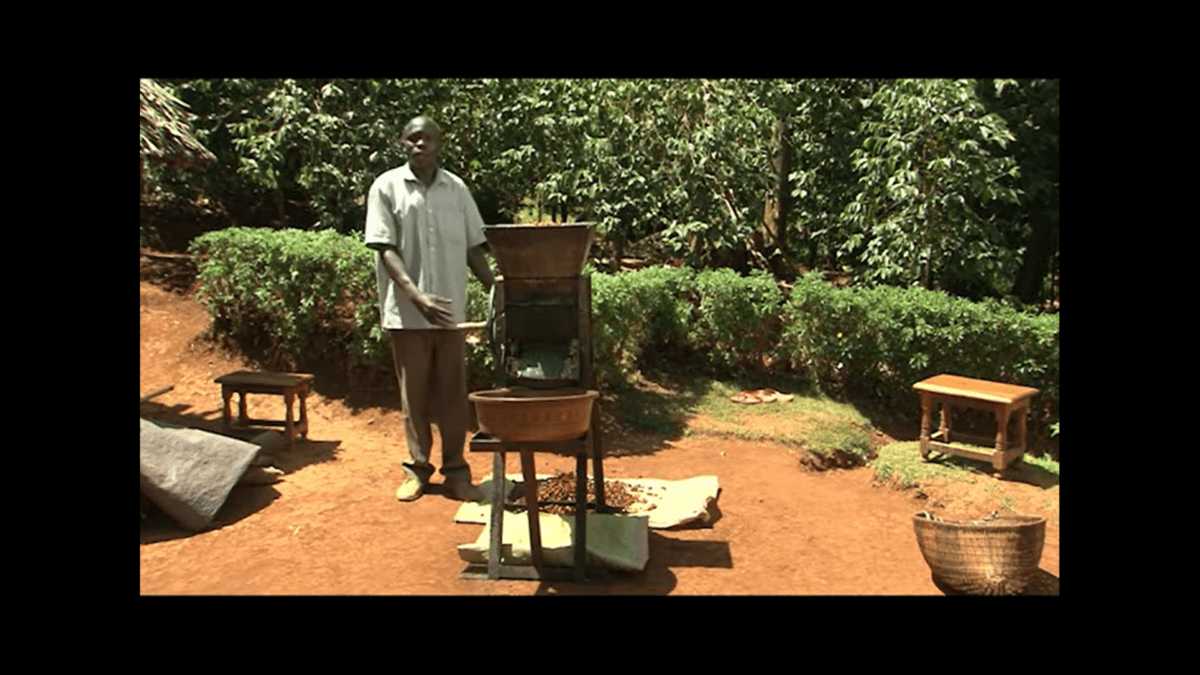
This is a more advanced method involving the use of different equipment and water to best process the cherries.
- Sorting: First, if the cherries were previously strip picked, they are sorted by hand to remove any unqualified berries that slipped in.
- Floating: They are then poured into water channels or smaller water containers to be separated by weight. The heavier and good ones will sink to the bottom, while the lighter which are usually not ripe or were attacked by pests would float on the surface.
- De-pulping: The pulp and skin are separated from the beans using the pulping machine. If the beans aren’t de-pulped, they’re still not ripe and should be picked by hand and grouped with the lighter batch. The husks can be collected and dried to be used as manure.
- Fermentation & Wash: To remove the mucilage, the sticky gooey fluid on the beans, they are put into fermentation tanks filled with water and left there for around 12 to 48 hours depending on the local climate and the thickness of the mucilage layer and other beans’ conditions. After the fermentation is completed, the beans are washed thoroughly with water. Also see more on anaerobic fermentation processing.
- Drying: The beans, now still covered by the parchment envelope and the silver layer, are now sundried on a large table or floor, flipped and turned regularly. The dried coffee beans that have reached 11-13% of moisture level are now called premium parchment beans.
Milling Coffee Beans
After the coffee beans are processed and dried, there are 3 additional processes before they are ready for shipping.
Hulling
Hulling removes the parchment paper from wet-processed coffee beans and the husk from dried-processed beans.
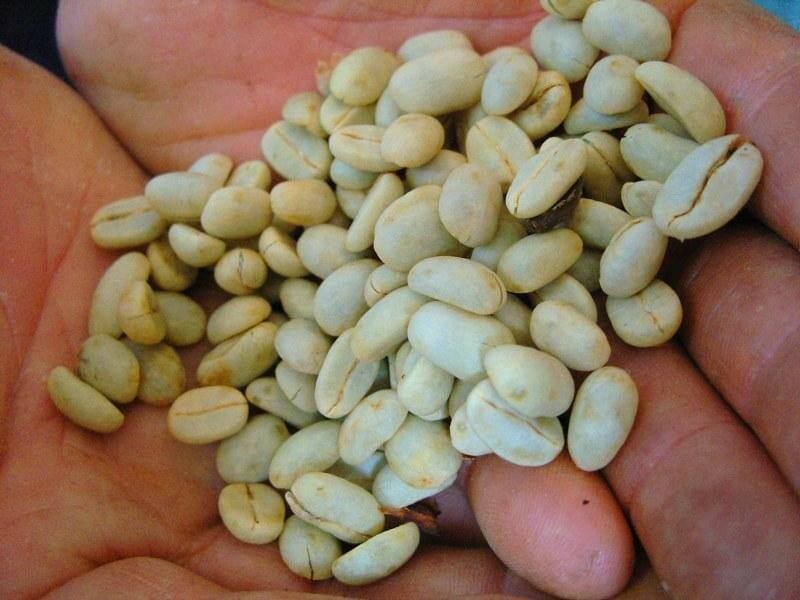
Polishing
Polishing removes any leftover silver skin on the coffee, but it’s optional.
Grading & Sorting
Once again, each coffee bean is sorted by size and weight and removed if it’s unqualified in terms of size, color, health, and processing quality, before making its way to the world of coffee exporting and shipping biz and reaching your hand to become roasted coffee, ground, and brewed.

I hope you got to know a thing or two more about the behind-the-scenes of the dark brown bean and coffee you come into contact with so frequently.
Personally, I’m reminded of all of the hard work that went into producing each coffee bean that has traveled the world each time I drop a packet in the shopping cart.
Where Does Coffee Come From Illustration

Go here to learn more about the history and origins of coffee?

